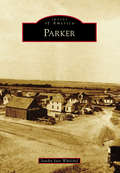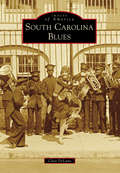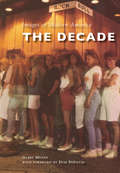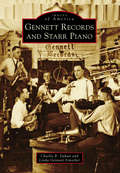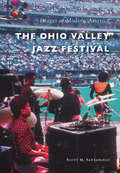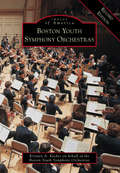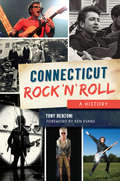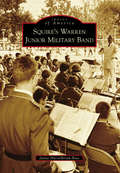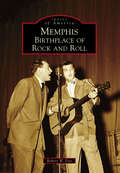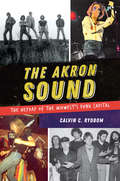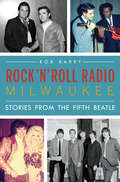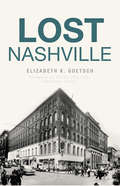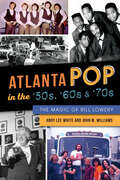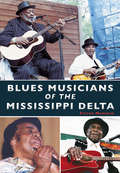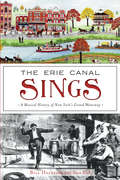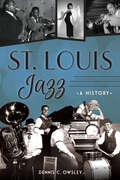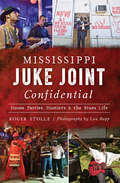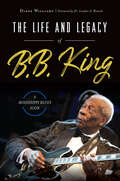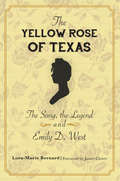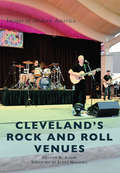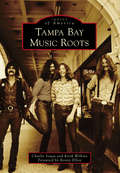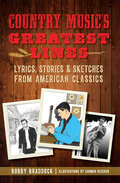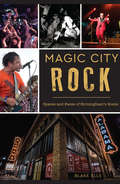- Table View
- List View
Parker
by Sandra Jane WhelchelThe town of Parker underwent several name changes before adopting its current title. First called Pine Grove for its setting in a copse of ponderosa pines at the northern edge of Colorado's Black Forest, that name lasted through the final days of stagecoach travel. When the US Post Office officially began operations in the 1880s, officials requested that Pine Grove be renamed, as another town with that name existed on the Platte River, causing the mail to be mixed up. James Sample Parker requested that the town's name be changed to Edithville, in honor of his young daughter. Again, the US Post Office denied the request, renaming the town Parker to recognize James Sample Parker and his brother, George. From these early beginnings, Parker faced spurts of growth and recession, more recently becoming a significant Denver suburb.
South Carolina Blues
by Clair DeluneThe history of South Carolina blues is a long, deep--and sometimes painful--story. However, it is a narrative with aspects as compelling as the music itself. Geographical differences in America led to variations in the styles of music that developed from African rhythms. The wet, marshy landscape and hot, muggy weather of the Carolina Lowcountry combined to cultivate not only rice, but a Gullah-based style of South Carolina blues. In drier climates, toward the Midlands and the Upstate, the combination of European influences led to the emergence of Piedmont blues, which in turn spawned country music as well as bluegrass. Those same Gullah roots resulted in four major dance crazes, starting with the Charleston.
The Decade (Images of Modern America)
by Gabby Means Dom DisilvioThe Decade was the birthplace of rock 'n' roll in Pittsburgh, at the corner of Atwood and Sennott. The eclectic bar with parachutes covering the ceiling was home base for local bands such as the Iron City Houserockers, but it also served as a showcase for rising international recording acts, including the Police, U2, the Red Hot Chili Peppers, and the Ramones. Under the shadow of the University of Pittsburgh, The Decade was an oasis of live rock and blues music in the 1970s to the early 1990s. The small venue had wide appeal to bands who felt they could intimately connect with their audience. Owned and operated by Dom DiSilvio, The Decade will forever be a home to many Pittsburghers, and Images of Modern America: The Decade is a home for their stories.
Gennett Records and Starr Piano (Images of America)
by Charlie B. Dahan Linda Gennett IrmscherThe Starr Piano Company, based in Richmond, Indiana, quickly became one of the largest piano manufacturers in the United States during the 19th century. In 1915, the Starr Piano Company opened a recording division, Gennett Records, that led to a dynamic change in the music industry and American culture. Gennett embraced the vastly under-recorded genres of jazz, blues, and country music in the 1920s. They recorded artists who were groundbreakers and innovators in both popular and vernacular music, including Louis Armstrong, Charley Patton, Gene Autry, Hoagy Carmichael, Blind Lemon Jefferson, Uncle Dave Macon, and Jelly Roll Morton, often for the first time. The company, like many others, suffered a steep decline in the sale of their pianos and records due to the Great Depression, but the music recorded at Gennett continues to reach new generations and influence musicians as they discover it on reissues and streaming media services.
The Ohio Valley Jazz Festival (Images of Modern America)
by Scott M. SantangeloCincinnati, Ohio, might have seemed like an unlikely choice to host the nation's largest annual R&B concert, but thanks to local promoter Dino Santangelo, the Ohio Valley Jazz Festival would become the "Granddaddy of Them All." The first festival was held in 1962 at the Carthage Fairgrounds, but the event would continue to grow--moving to Crosley Field in 1964 and then Riverfront Stadium in 1971--to become the nation's biggest two-day stadium concert. The Ohio Valley Jazz Festival would eventually feature the most popular R&B artists of the day and draw audiences from as far as 500 miles away. The festival pioneered stadium concert production, generated millions for the regional economy, and eased the Greater Cincinnati community's difficult cultural transition throughout the turbulent 1960s and 1970s.
Boston Youth Symphony Orchestras Revised Edition (Images of America)
by Krysten A. KechesIn 1958, under the founding music director, Prof. Marvin Rabin, the Boston University College of Fine Arts established a youth orchestra for junior and senior high school students from the Greater Boston area. The Boston Youth Symphony Orchestras (BYSO), formerly known as the Greater Boston Youth Symphony Orchestras, has flourished over the past 60 years, impacting the lives of thousands of young musicians. BYSO members have experienced countless unforgettable moments, including performances at the White House, Carnegie Hall, and renowned concert venues across the world. Today, under the musical leadership of Federico Cortese, BYSO serves 500 students from over 120 communities throughout New England. BYSO is one of Boston�s most prestigious arts organizations, with a programmatic scope that includes three full symphonic orchestras, two young string training orchestras, six chamber orchestras, a preparatory wind ensemble, a chamber music program, and a nationally recognized outreach program that provides rigorous instrument instruction to students from underrepresented communities. In 2008, BYSO established an opera program that has become an integral part of the season repertoire. BYSO has selected images from its extensive archives to exhibit its rich history.
Connecticut Rock ‘n’ Roll: A History
by Ken Evans Tony RenzoniLong neglected in the annals of American music, the Nutmeg State’s influence on the history of rock’n’roll deserves recognition. Connecticut’s musical highlights include the beautiful harmonies of New Haven’s Five Satins, Gene Pitney’s rise to fame, Stamford’s the Fifth Estate and notable rockers such as Thurston Moore of Sonic Youth, Rivers Cuomo of Weezer and Saturday Night Live Band’s Christine Ohlman. Rock Hall of Famers include Tina Weymouth and Chris Frantz of the Talking Heads and Dennis Dunaway of the Alice Cooper Band. Some events became legend, like Jimi Hendrix’s spellbinding performance at Yale’s Woolsey Hall, Jim Morrison’s onstage arrest at the New Haven Arena and teenage Bob Dylan’s appearance at Branford’s Indian Neck Folk Festival. With in-depth interviews as well as rare, never-before-seen photos, author Tony Renzoni leads a sonic trip that captures the spirit and zenith of the local scene.
Squire's Warren Junior Military Band (Images of America)
by Janne Hurrelbrink-BiasSquire�s Warren Junior Military Band had an emotional appeal that endeared it to audiences of all ages. Considered one of northeastern Ohio�s richest artistic assets, the band�s members, who hailed from the entire region, were filled with pride, tradition, patriotism, and a sense of discipline. The original VFW Boys Band was formed in 1927, with Donald W. �Squire� Hurrelbrink becoming director in 1930. In 1957, the name changed to the Warren Junior Military Band. Travels took the band from the East Coast to the West Coast, from Canada to the Gulf of Mexico, and to audiences abroad, amassing an impressive record of Midwest, Canadian, European, American Legion, and VFW National Championships. Throughout the years, the band performed at numerous prestigious events and for an impressive number of dignitaries, as well as a phenomenal number of local, civic, and patriotic festivities. Members were privileged to have Squire�s leadership for 66 years. Alumni continued to lead, direct, and pass on the values they learned under Squire�s guidance. Finally, in 2010, the band ended its long legacy.
Memphis: Birthplace of Rock and Roll (Images of America)
by Robert W. DyeThe music that has been produced in Memphis over the past 100 years is as unique and diverse as the city itself. Growing out of the Mississippi Delta, the Memphis blues have been transported worldwide by such ambassadors as B.B. King and Howlin' Wolf. Rock's first baby steps were taken at the tiny Sun Studio by a group of artists who have inspired generations of musicians to follow in their beat. Soul music found its groove at Stax with a homegrown sound that exploded onto the American music scene. Music producers, including Sam Phillips, Willie Mitchell, Chips Moman, and Jim Stewart, found in Memphis a sound as distinctive as their individual personalities. Each one inspired, motivated, and encouraged their artists and, in doing so, produced a volume of work that has become the sound track of their generation.
The Akron Sound: The Heyday of the Midwest's Punk Capital
by Calvin C. RydbomMusic made in Akron symbolized an attitude more so than a singular sound. Crafted by kids hell-bent on not following their parents into the rubber plants, the music was an intentional antithesis of Top 40 radio. Call it punk or call it new wave, but in a short few years, major labels signed Chrissie Hynde, Devo, the Waitresses, Tin Huey, the Bizarros, the Rubber City Rebels and Rachel Sweet. They had their own bars, the Crypt and the Bank. They had their own label, Clone Records. They even had their own recording space, Bushflow Studios. London's Stiff Records released an Akron compilation album, and suddenly there were "Akron Nights" in London clubs and CBGB was waiving covers for people with Akron IDs. Author Calvin Rydbom of the "Akron Sound" Museum remembers that short time when the Rubber City was the place.
Rock `n´ Roll Radio Milwaukee: Stories from the Fifth Beatle
by Bob BarryBob Barry ruled Milwaukee's airwaves in the '60s and '70s. The only time the Beatles performed here, Barry introduced them to the audience, and he was the only local personality who spent time in private with the Fab Four. If a band or musician came to town, he met them with a microphone. Chuck Berry, the Animals, Wings, the Rolling Stones--the list goes on. His popular "Bob Barry Calls the World" segment entertained thousands with cold calls to famous personalities, including Bob Hope, Sophia Loren, Elton John and Cher. Through it all, Barry maintained a calm and fun-loving demeanor, even when mocked by the WOKY Chicken or nearly eaten by wolves on the air. Packed with never-before-seen photos, this revealing memoir recalls the iconic DJ's many celebrity encounters, his career highlights and setbacks and the hijinks that made Milwaukee radio rock.
Lost Nashville (Lost)
by Betsy Phillips Elizabeth K. GoetschNashville is chock- full of music landmarks, but there are quite a few historic structures that have been lost to time. The elegant Maxwell House Hotel served a breakfast blend that grew into the nationally known coffee brand. Public transportation first arrived in Nashville by way of horse-pulled streetcars in the 1860s. Fort Negley was the largest stone fort built during the Civil War. The Nashville Female Academy once served as the largest school for young ladies in the United States during the nineteenth century. Author Elizabeth Goetsch digs into the archives for some of the Music City's lost structures.
Washington, DC, Jazz (Images of America)
by Dr. Regennia Williams Rev. Dr. Butler-TruesdaleHome to "Black Broadway" and the Howard Theatre in the Greater U Street area, Washington, DC, has long been associated with American jazz. Duke Ellington and Billy Eckstine launched their careers there in the early 20th century. Decades later, Shirley Horn and Buck Hill would follow their leads, and DC's "jazz millennials" include graduates of the Duke Ellington School of the Arts. For years, Bohemian Caverns and One Step Down were among the clubs serving as gathering places for producers and consumers of jazz, even as Rusty Hassan and other programmers used radio to promote the music. Washington, DC, Jazz focuses, primarily, on the history of straight-ahead jazz, using oral histories, materials from the William P. Gottlieb Collection at the Library of Congress, the Felix E. Grant Jazz Archives at the University of the District of Columbia, and Smithsonian Jazz. This volume also features the work of photographers Nathaniel Rhodes, Michael Wilderman, and Lawrence A. Randall.
Atlanta Pop in the '50s, '60s & '70s: The Magic of Bill Lowery
by Andy Lee White Williams M JohnDiscover the people and places that made Atlanta the pop music capital of the United States in the second half of the twentieth century.Former DJ Bill Lowery attracted a galaxy of talent and created an empire of music publishing, production and promotion. In 1956, the Lowery Music Company had its first million copy-selling hit single with &“Be-Bop-a-Lula,&” by Gene Vincent. Under Lowery&’s direction, popular artists like Tommy Roe and Billy Joe Royal flourished. Audio engineer Rodney Mills teamed up with Lowery and future Atlanta Rhythm Section manager Buddy Buie to build Studio One, a recording studio that produced albums from legendary acts such as Joe South, Lynyrd Skynyrd, 38 Special and others. Andy Lee White and John M. Williams offer a comprehensive portrait of the vibrant postwar Atlanta music scene.&“Insight and memories from major behind the scenes figures like engineer, producer and Georgia Music Hall of Fame member, Rodney Mills (Lynyrd Skynyrd, Atlanta Rhythm Section, Gregg Almond, Joe South) along with Bob &“Tub&” Langford (engineer for Joe South&’s biggest hits and Lynyrd Skynyrd&’s &“Freebird&”) help tell previously untold memories from a special time for Atlanta music like none before or since.&” —East Cobber
Blues Musicians of the Mississippi Delta
by Steven ManheimThe Mississippi Delta blues run as deep and mysterious as the beautiful land from where the music originates. Blues legends B.B. King, Muddy Waters, John Lee Hooker, Howlin' Wolf, Sonny Boy Williamson, and countless other greats came from this region. The Delta blues, born as work songs in Mississippi cotton fields, was played on city street corners and in rural juke joints. With the Great Migration of African Americans in the first half of the 20th century, the Delta blues also made its way from Mississippi to Chicago. The sound of the blues would become the blueprint for the birth of rock and roll in Memphis in the 1950s. The era of the great Delta blues musicians is over, but their legacy remains an important chapter in American music. This book contains images of these important performers and the rich Delta landscapes that influenced their music.
Erie Canal Sings, The: A Musical History of New York's Grand Waterway
by Bill HullfishLife working along the banks of the Erie Canal is preserved in the songs of America's rich musical history. Thomas Allen's "Low Bridge, Everybody Down" has achieved iconic status in the American songbook, but its true story has never been told until now. Erie songs such as "The E-ri-e Is a-Risin'" would transform into "The C&O Is a-Risin'" as the song culture spread among a network of other canals, including the Chesapeake and Ohio and the Pennsylvania Main Line. As motors replaced mules and railroads emerged, the canal song tradition continued on Broadway stages and in folk music recordings. Author Bill Hullfish takes readers on a musical journey along New York's historic Erie Canal.
St. Louis Jazz: A History
by Dennis C OwsleyExplore the history of the artists who contributed to the Gateway City&’s jazz scene and the world of music.In the early twentieth century, St. Louis was a hotbed for ragtime and blues, both roots of jazz music. In 1914, Jelly Roll Morton brought his music to the area. In 1919, Louis Armstrong came to town to play on the &“floating conservatories&” that plied the Mississippi. Miles Davis, the most famous of the city&’s jazz natives, changed the course of the genre four different times throughout a world-renowned career. The Black Artists Group of the 1970s was one of the first to bring world music practices into jazz. Author Dennis C. Owsley chronicles the ways both local and national St. Louis musicians have contributed to the city and to the world of music.
Mississippi Juke Joint Confidential: House Parties, Hustlers & the Blues Life
by Roger StolleJuke joint--two words often used, often abused. They convey an inherent promise of something real, edgy, from another time. All juke joints are blues clubs, but not all blues clubs are jukes. Here, artist recollections and insights delve below the murky surface to tell the tales, canonize the characters and explain the special brand of blues bottled in these quasi-legal establishments. Author Roger Stolle works from the inside to educate and entertain with a mix of history, anecdote and discovery. It's a wild ride.
Life and Legacy of B. B. King: A Mississippi Blues Icon (American Heritage)
by Diane WilliamsThis biography of the iconic blues musician features interviews with family members, fellow musicians, and those who knew his best.Born on a cotton plantation in 1925, Riley B. King would grow up to be one of the most influential blues musicians of all time, being crowned &“The King of the Blues.&” Never wavering from his vocation, King gathered other musicians together and melded them into the unique blues sound that would become his signature. In this intimate portrait of B. B. King, author Diane Williams offers a brief account of the monumental blues man's life before settling in for a series of interviews with his bandmates and beloved family members. The Life and Legacy of B. B. King offers an intimate view of the man behind the music.
Knoxville Music before Bluegrass (Images of America)
by Tim SharpSince colonial times, generations of families from Ireland, Scotland, Wales, and England have settled in Knoxville and East Tennessee. Early on, they arrived with ballads, stories, instruments, and folk music from their former homes. "Songcatchers," including Francis James Child, Olive Dame Campbell, Maud Pauline Karpeles, Cecil J. Sharp, William Francis Allen, Lucy McKim Garrison, Charles Pickard Ware, and George Pullen Jackson, journeyed deep into the remotest areas of East Tennessee to capture their songs in the late 19th and early 20th centuries. This music existed almost unchanged until the introduction of commercial recording and radio broadcasting in the 1920s. The historic recording sessions in Bristol, Tennessee, in the summer of 1927 sparked new genres of music, and through the contribution of musicians like Lester Flatt, Josh Graves, Dolly Parton, Earl Scruggs, Ralph Stanley, the Carter Family, Bill Monroe, and many others, Knoxville and East Tennessee are acknowledged for the roles they played in the birth of country and bluegrass music.
The Yellow Rose of Texas: The Song, the Legend and Emily D. West
by Lora-Marie BernardA journalist searches for the truth behind the traditional folk song, and a free black woman’s role in the Texas Revolution.The legend of the Yellow Rose of Texas holds an indisputable place in Lone Star culture, tethered to a familiar song that has served as a Civil War marching tune, a pop chart staple, and a halftime anthem. Almost two centuries of Texas mythmaking successfully muddled fact with fable in song, and the true story of Emily D. West remains mired in dispute and unrecognizable beneath the tales that grew up around it. The complete truth may never be recovered, but in this book Lora-Marie Bernard seeks an honest account honoring the grit and determination that brought a free black woman from the abolitionist riots of Connecticut to the thick of a bloody Texas revolution. A Lone Star native who grew up immersed in the Yellow Rose legend, Bernard also traces other stories that legend has obscured, including the connection between Emily D. West and plans for a free black colony in Texas.Includes illustrations
Cleveland's Rock and Roll Venues (Images of Modern America)
by Deanna R. AdamsCleveland has always been a music town. And thanks to Cleveland deejay Alan Freed, who booked the first venue for rock enthusiasts, music fans have never lacked for places to go see their favorite acts perform in person. This book honors the astute owners and their venues--from yesterday to today--that present fans with the music they crave. The early clubs helped usher in Cleveland as the designated Rock and Roll Capital of the World. Today's venues continue the tradition, thus ensuring that music lovers of all ages, and attitudes, get to enjoy their rock and roll on the North Coast, with all its variety and talent. Because of them, musical memories continue to be made.
Tampa Bay Music Roots (Images of America)
by Charlie Souza Keith WilkinsWhen the Peerless Quartet wrote "Way Down On Tampa Bay" in 1914, Tampa Bay's musical roots started growing. Tampa Bay is where Ray Charles created his first song, Hank Ballard wrote and recorded "The Twist," and the Rolling Stones cranked out their hit "Satisfaction." Stephen Stills attended both Plant High School and Admiral Farragut Academy, and Jim Morrison studied at St. Petersburg Junior College. Ella Fitzgerald kicked off her career on the storied Central Avenue in Ybor City. Savatage, Stranger, Diamond Grey, the Outlaws, Bleeding Hearts, Blackkout, the Arena Twins, Tampa Red, and Cheeky Monkey are all artists who have made a huge impact both locally and nationally. From its rock 'n' roll boom in the 1960s to the birth of death metal in the 1980s . . . Tampa Bay has had a rich musical history!
Country Music's Greatest Lines: Lyrics, Stories & Sketches from American Classics
by Bobby Braddock&“One of country music&’s greatest songwriters has given us his own private tour of the collective genius of his profession.&” —Malcolm Gladwell, bestselling author and host of the Revisionist History podcast Bobby Braddock, the only living songwriter to have written number-one country songs in five consecutive decades, celebrates standout lines in more than eighty country masterpieces. Unique stories give the reader a behind-the-scenes look at classics from Hank Williams, Bill Anderson, Roger Miller and Merle Haggard, as well as twenty-first-century icons like Alan Jackson, Taylor Swift and Eric Church. Artist Carmen Beecher brings these tales to vivid life with strikingly realistic illustrations of seldom-seen songwriters, easily recognizable superstars and unforgettable song characters. From late 1940s jukebox hits to present-day chart toppers, Braddock and Beecher offer a magical journey from the songwriter&’s pen to the singer&’s lips to the listener&’s ear. &“Country Music&’s Greatest Lines works as an insider&’s take on the business of country, and it also sent me to a dozen records I wanted to hear immediately. Braddock and Beecher evoke the mythology of country without sentimentalizing the music or its creators. It&’s a remarkable achievement.&” —Nashville Scene &“We see how stand-alone powerful and effective a few well-crafted lines can be, even when removed from the context of the entire song.&” —Sounds Like Nashville &“Country songs, from Hank Williams till today, remain faithful to their tradition of reminding their listeners about the life they live. Braddock, a 60-year creator of songs, remembered that when he decided to write this book.&” —American Songwriter
Magic City Rock: Spaces and Faces of Birmingham’s Scene
by Blake EllsBirmingham's rock music scene has thrived on camaraderie and collaboration for decades. With no competitiveness, it has maintained a punk rock ethos while also appealing to a mainstream audience, thanks to DIY clubs and alternative radio support. Once one of the country's most successful AAA radio stations, 107.7 The X and the A&R power of station head Scott Register provided the early radio success that helped break Train, Matchbox Twenty and John Mayer. The same scene produced Jim Bob & the Leisure Suits, the Primitons, the Sugar La Las and Verbena. From local legends like Hotel and Telluride to national sensation St. Paul and the Broken Bones, writer Blake Ells tells the story of the Magic City's indelible stamp on the history of modern rock.
